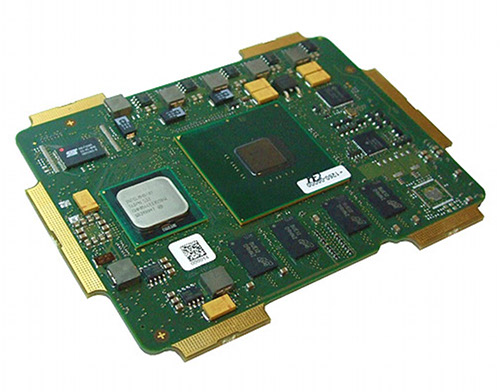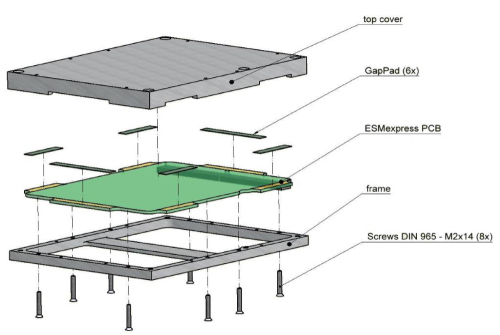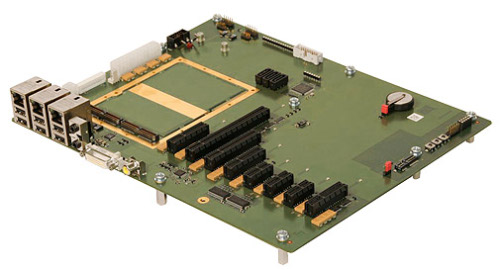Rugged COM format gets even tougher
Mar 10, 2010 — by LinuxDevices Staff — from the LinuxDevices Archive — viewsMEN Micro announced a COM (computer-on-module) employing its own ESMexpress format along with Intel's Atom Z5xxP or PT processors. The XM1L has up to 2GB of soldered-on RAM plus a SATA port, uses less than seven watts, operates from -40 to 185 deg. F, and withstands shocks up to 15G, the company says.
MEN Micro's XM1L is a new version of the XM1, a module that made its debut in 2008 along with the company's ESMexpress COM format. For background on this inherently rugged design, see later in this story.
The XM1L gains a wider operating range — from -40 to 185 deg. F — than the XM1 had, thanks to its adoption of Intel's Z5xxP or PT processors. Introduced a year ago, these Atom variants are architecturally identical to the original Z5xx Atoms, with the same clock speeds and TDPs. However, they measure 22 x 22mm instead of the original 14 x 13mm, allowing incorporation of integrated heat spreaders.
The 1.6GHz Z530P and 1.1GHz Z510P have a rated operating range of 0 to 60 deg. C (32 to 140 deg. F), like the original Atoms. Also available, though, are the 1.33GHz Z530PT and 1.1GHz Z510PT, rated for an industrial operating range from -40 to 85 deg. C (-40 to 185 deg. F).
MEN Micro offers all four of the above processors as choices on the XM1L, which also includes Intel's larger (37.5 x 37.5mm instead of 22 x 22mm) SCH US15WP or PT northbridge/southbridge chip. You can see the larger size of these components by comparing the XM1L, immediately below, with the XM1 pictured later in this story.

MEN Micro's XM1L
According to MEN Micro, the XM1L additionally differs from the XM1 in that it is now available with 2GB of soldered-on memory, instead of the original 1GB limit. Otherwise, the device is said to be much as before, with a full-load power consumption that ranges from five to seven Watts, a covered frame on top of which a heat sink can be placed, and ESMexpress connnectors relaying all its interfaces to the outside world.
MEN Micro says the XM1L has one SATA port, eight USB ports (seven host, one client), a gigabit Ethernet port, and HD audio. Graphics support again extends to both LVDS and SDVO, though maximum resolution is now said to be 1600 x 1200 pixels instead of the previous maximum of 1366 x 768. The module offers a single PCI Express x1 expansion interface, plus a second x1 link that may be employed if the local gigabit Ethernet controller is not being used, MEN Micro says.
Like the XM1 before it, the XM1L is rated to withstand shocks of 15G for 11ms, bumps of 10G for 16ms, or sinusoidal vibration of up to 1G between 10 and 150Hz. According to MEN Micro, the module delivers its -40 to 185 deg. F operating range regardless of whether P or PT processors have been chosen, but in the former case the CPUs are said to have been "screened," whereas in the latter case they're said to have been "qualified."
Features and specifications listed by MEN Micro for the ESMexpress XM1L include the following:
- Processor — 1.6GHz Intel Atom Z530P, 1.1GHz Z510P, 1.33GHz Z520PT, 1.1GHz Z510PT
- Chipset — SCH US15WP or PT
- Memory — Up to 2GB of soldered-on DDR2 RAM
- Expansion:
- 1 x PCI Express x1 with Ethernet, or 2 x PCI Express x1 without Ethernet
- Networking — Gigabit Ethernet
- Other I/O:
- 8 x USB 2.0 (7 host, 1 client)
- LVDS
- SDVO (not on 1.1GHz models)
- 1 x SATA
- 1 GPIO line for LED
- SMbus
- Operating range — -40 to 185 deg. F (-40 to 85 deg. C)
- Power consumption — 12VDC nominal (tolerates 9 to 16 Volts); 5 to 7 Watts
- Dimensions — 4.92 x 3.75 inches (125 x 95mm)
Background
MEN Micro says its ESMexpress format remains poised to be designated as an American National Standards Institute (ANSI) standard by the VME Industry Trade Association (VITA), and will be dubbed ANSI-VITA 59 RSE (rugged system-on-module express). The design of the 4.9 x 3.75 inch modules had the following goals, according to the company:
- Power dissipation of up to 35 watts
- Cooling by both conduction and convection
- An open processor architecture
- Extreme resistance against shock and vibration
To achieve these goals, ESMexpress modules are screwed into a frame (below) and then optionally enclosed in an aluminum housing. The high pressure caused by the screw joints between the housing and the PCB supports the thermal connection of the components. If additional cooling is required, the housing can be connected to a heat sink or other external heat dissipation system; at the same time, the housing ensures optimal EMC (electromagnetic compatibility) protection for the electronic parts, says MEN Micro.

The ESMexpress modules are screwed tightly into a frame
(Click to enlarge)
The electrical signals from the module are distributed on one or two 120-pin connectors, depending on the required functionality. ESMexpress provides four single-lane PCI Express ports and one port which can be configured as one x16, one x8, two x4, or two x1 ports. Additionally possible are three gigabit Ethernet ports, eight USB, three SATA, SDVO, LVDS, HD audio, several utility signals, and a single 12V power supply. Pin assignments are fixed, in order to guarantee the interchangeability of the ESMexpress modules.
According to MEN Micro, ESMexpress can also be made compatible with COM Express, via the company's AE12 carrier adapter. This product adapts both mechanics and pinouts so that ESMexpress modules can be used on COM Express carrier boards. Similarly, future adapters could be created that adapt COM Express modules to ESMexpress carrier boards, the company says.

The ATX-format XCI carrier board
The first ESMexpress carrier board was MEN Micro's ATX-format XCI. As illustrated by the photo above, it includes an ESMexpress slot, eight PCI Express slots, DVI video output, HD audio, and three SATA interfaces. Three "real-world" ports for gigabit Ethernet and six ports for USB 2.0 are also included.
An ESMexpress module can employ any processor architecture, says MEN Micro, as long as the maximum power dissipation of 35W is not exceeded. Two modules were released initially: the Atom-based XM1 (below) and the Power PC-based XM50.

MEN Micro's XM1
(Click to enlarge)
The XM1 includes the 1.1GHz Atom Z510 or 1.6GHz Z530 processor, along with the US15W SCH (system controller hub). It has up to 1GB of soldered DDR2 memory, and carries the same specifications for resistance to shock and vibration as the newer XM1L.
Availability
The ESMexpress XM1L is compatible with Linux, VxWorks, and QNX, as well as Windows 2000, XP, Vista, Embedded Standard, and CE, according to MEN Micro. Deliveries of the product, whose pricing starts at $497, will begin in approximately six weeks, the company adds.
Further information on ESMexpress can be obtained from the MEN Micro website, here. More information on the XM1L may be found on the company's website, here.
This article was originally published on LinuxDevices.com and has been donated to the open source community by QuinStreet Inc. Please visit LinuxToday.com for up-to-date news and articles about Linux and open source.